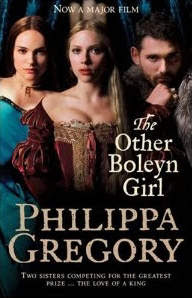Historical Fiction Challenge
 Mary is the greatest Boleyn girl at the court of Henry VIII. Young, beautiful, and safely married, she has caught the eye of the king himself. Her ambitious Boleyn and Howard relatives are determined that she should keep it, no matter what it takes. With Queen Katherine slowly aging and only one small girl as heir, Henry needs a son, and there is much to be gained by the family of the girl who can provide it. Soon Mary is a royal mistress, torn between her love of the king and her duty as a lady in waiting to his wife.
Mary is the greatest Boleyn girl at the court of Henry VIII. Young, beautiful, and safely married, she has caught the eye of the king himself. Her ambitious Boleyn and Howard relatives are determined that she should keep it, no matter what it takes. With Queen Katherine slowly aging and only one small girl as heir, Henry needs a son, and there is much to be gained by the family of the girl who can provide it. Soon Mary is a royal mistress, torn between her love of the king and her duty as a lady in waiting to his wife.
Mary’s sister Anne changes everything. Pushed forward by her father and uncle to hold the king in the Howard interest during Mary’s second pregnancy, she sets out to secure Henry for herself. Having been thwarted in her scheme to become Duchess of Northumberland, Anne now has her sights firmly on the throne. All she has to do is lead Henry on until he can be rid of his inconvenient wife. Now Mary is the other Boleyn girl, forced to watch as the arrogance and rapacity of her family drives them all toward disaster.
As a novel, I liked it, or at least I did once a few years had passed and I no longer had to deal with the creepiness of Henry chasing after a 14-year-old girl. It would be hard not to feel for Mary, a (comparatively) innocent girl with modest dreams and the misfortune to have been born into one of the most power-hungry families in the land. The strongest and most self-willed of people would have had a challenging time escaping the machinations of her parents and uncle; Mary had no chance. I was cheering for her all the way as she found the courage to build a life of her own choosing with the adorable William Stafford. (I’ve often wondered why all the good men are fictional, and here’s one who’s fictional and centuries dead.)
And really you have to like Mary, because there are precious few other characters to feel any sympathy for. Her brother George has charm, Anne has brains and intense dedication to her goal, but no other admirable qualities. Their parents, their uncle, and George’s poisonous wife Jane seemingly have none. The first-person viewpoint really helps here; all their nastiness is filtered through the eyes of an agreeable character. Mary’s love of her siblings, despite their flaws, makes their calculation and manipulations tolerable to read about; and I even felt a few glimmerings of pity for Anne as she was ground down by the strain of maintaining the role she had chosen for herself, urged on by her ruthless relatives.
Being based on real events, there was no question over how it would end. Yet I couldn’t stop turning the pages to see what happened next, to find out how Mary would save her children and herself from the downfall of the rest of the Boleyns. Given than most of the characters were people I didn’t like, that’s quite an accomplishment.
As history, it sucked. Sure, some historians think Mary was born in 1508, as she was here; but the majority opinion is that she was nine years older. And the truth is that she returned from the French court in 1519 with a scarlet reputation and a number of affairs behind her, all of which got neatly omitted in the novel. It certainly made a better story, having her naive rather than notorious; a heroine who was formerly the most infamous harlot of the French court would have been harder to like. It’s the contrast between the sisters which makes Anne into the villain, the effective foil to Mary’s good heart; if they were morally as bad as each other this would have been lost.
I didn’t buy the depictions of the other Boleyns and Howards any more than I did that of Mary. Surely it isn’t possible that they could have been so uniformly obnoxious and heartless? I pitied the real Anne far more than the fictional one, for the tarnishing of her reputation to make her sister shine the brighter. Since I generally dislike historical inaccuracies I feel a bit guilty for enjoying the book as much as I did.
Rating: B

















No comments:
Post a Comment